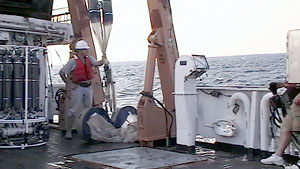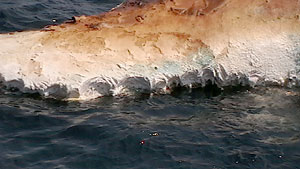

 | |||||||||||
|
|
Journals 2009/2010David Wehunt
August 18, 2009 Latitude: N 39° 16' 389" Today we worked 7 stations on my watch. At every station we tow bongo nets. However we added baby bongo nets to the tow. These were added after we pulled a twin set of jellies from the bottom. If I did not mention this before, the plankton tows we do are about 5 meters from the bottom. So we are after fish larvae and zooplankton. One side of the regular bongo net is dedicated to zooplankton while the other side is for fish larvae. The samples are bottled separately, preserved and then will be taken to a lab at the end of the cruise and processed. The sample dedicated to fish larvae will have all the fish larvae removed and studies with all other material tossed. The zooplankton will be quartered and quantified. I am not sure what the samples taken by the baby bongos are used for as quantity and separation do not matter.
During certain stations we also deploy a rosette with Nansen bottles to collect data for a different group of scientists who are studying nutrients and RNA. Enough about work, I want to make a couple of non-work related observations. Early in the morning I saw what appeared to be a low flying bird. I thought it might be a flying fish and it was! A crew member asked if anyone else saw the flying fish. It flew for about 150 yards. Later the NOAA officers spotted what appeared to be an overturned boat but it turned out to be the floating carcass of a whale. One crew member identified it as possibly a Right Whale. Sharks were eating when we arrived and they ranged up to 14 feet in length.
Well, the seas are getting rougher and we are hopefully going to be east of Hurricane Bill but we should have an interesting time with the swells. |
||||||||||

